Family : Triozidae

Text © Prof. Santi Longo

English translation by Mario Beltramini
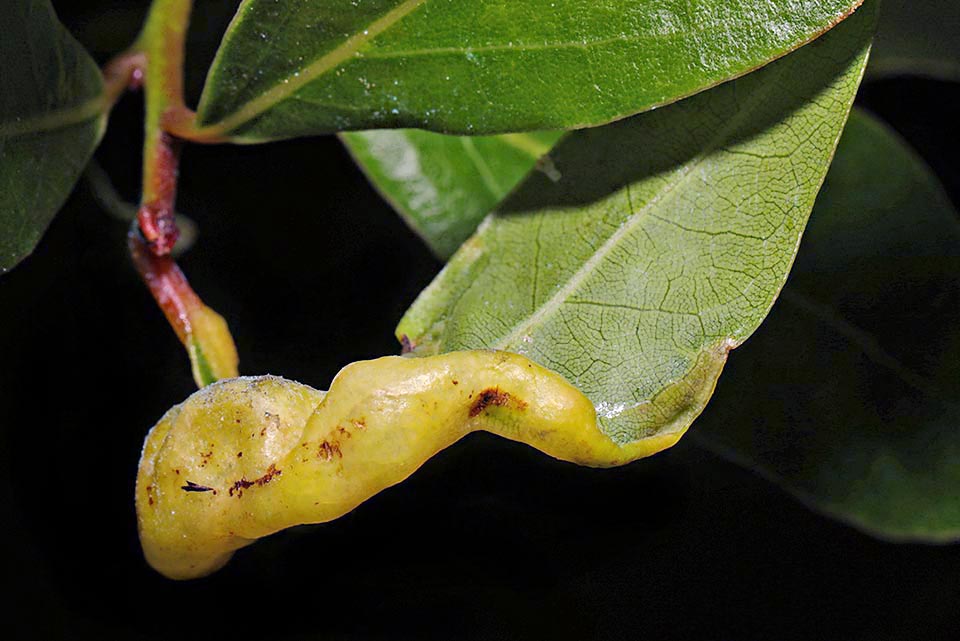
We easily note the presence of Laurel psylla (Lauritrioza alacris) with its characteristic foliar galls caused by the adults nutrition © Stephen James McWilliam
Inside the superfamily Psylloidea, in 1879 the entomologist Low, created the family Triozidae inserting there the species whose front wings have a trifurcated basal rib, unlike those of the family of Psyllidae Latreille 1807 whose basal rib is bifurcated.
The adults of the homoptera psyllids are small insects having a length varying from 1,5 to 4,5 mm.
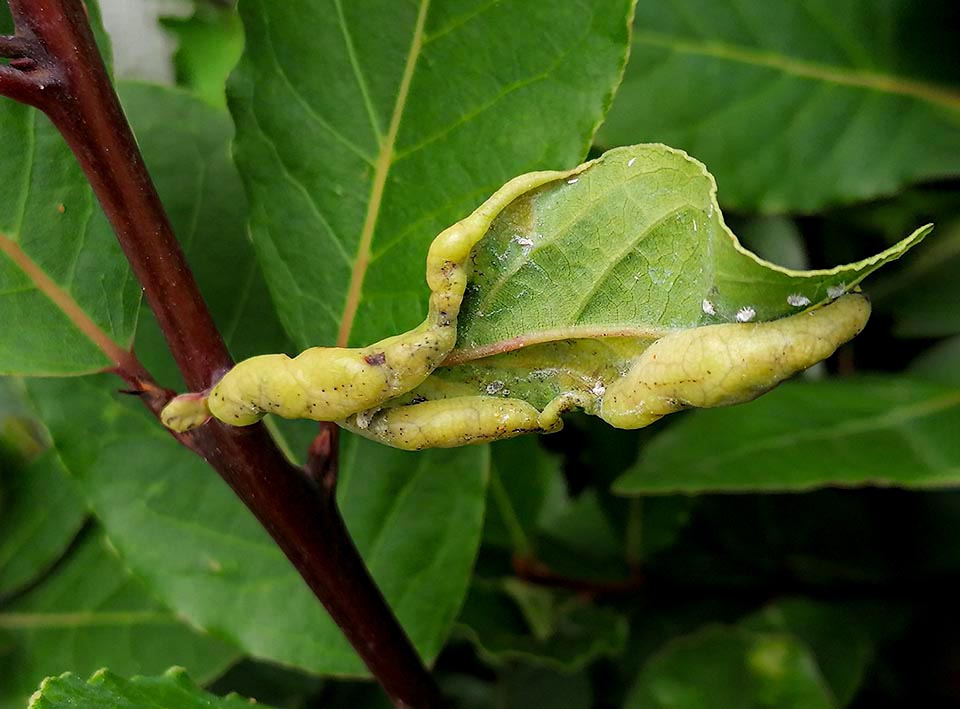
In fact these ones inject into the growing leaves tissues a saliva causing the folding of leaf margin towards the lower pagina with formation of a cavity © Butor and Gogol
In the head are often present two geno-frontal processes, called “frontal cones”, and three eyes. The antennae are formed by 10 articles. In the mouth apparatus, of pungent suckery type, the lower lip, called rostrum, is trimerous, that is formed by three articles.
In the meso- and in the meta-thorax are always present the membranous wings that, in the resting state, are kept as a roof and have simple ribs.
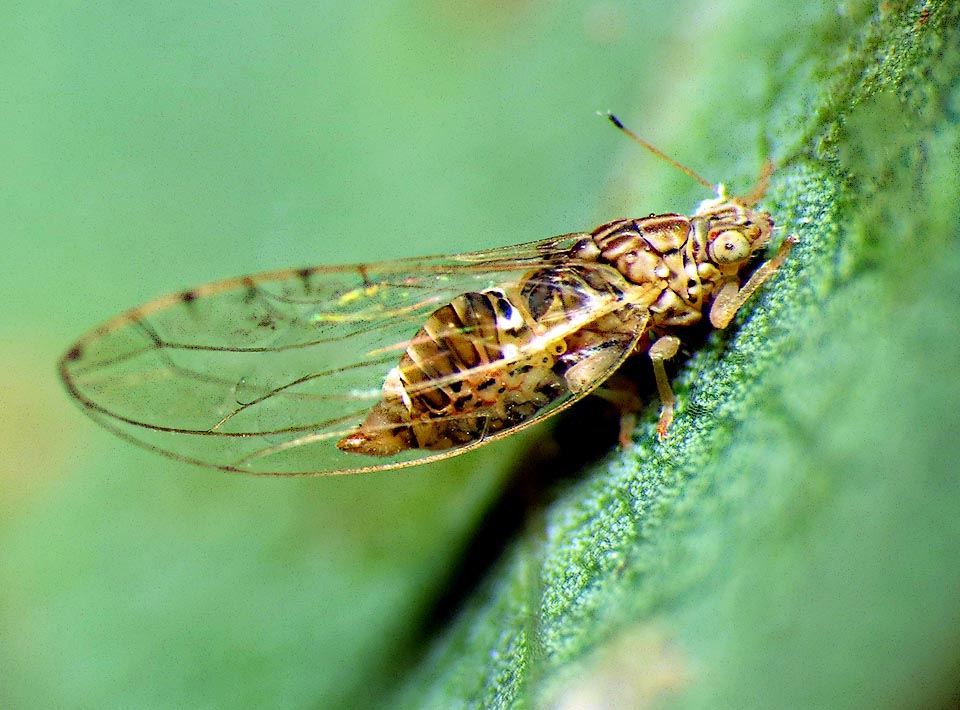
Lauritrioza alacris is an only 3,5-4 mm hemipteran, native to the Mediterranean Basin but now naturalized also in America © Katja Schulz
The legs have two-article tarsi: the front and the medium ones are ambulatory whilst the rear ones are more developed and are suitable for jumping. The ninth abdominal urite is large and has dorsally the tenth urite where is located the anal opening.
In the females the genito-anal system is formed by two variously elongated sclerified elements: one dorsal and one ventral dug like a groove that contain the morphological ovopositor.
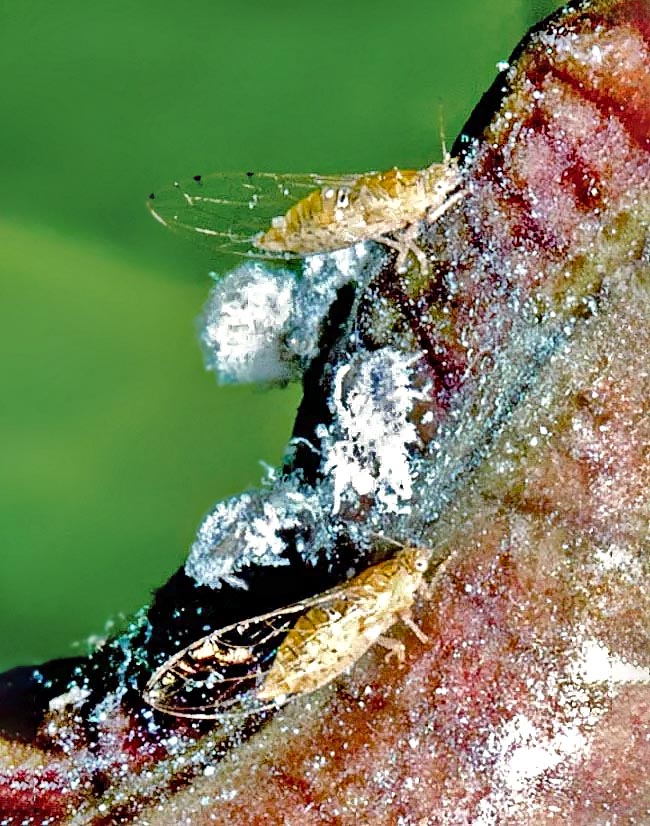
The colour of the adults’ livery varies: usually paler in those of the spring generations © Giuseppe Mazza
In the abdomen of the male the genital system is connected to the anus and is formed by the proctiger (formed by the 10th and 11th segments): by the sub-genital lamina; by two parameters and by the copulatory organ or aedeagus.
The colour of the adults’ livery is variable: normally it is clear in those of the spring generations, whilst is darker in the winter generations ones.
The eggs are equipped with a peduncle.
The post-embryonic development occurs through two nymphal stages, without wing buds, and three of nymph; that is three of neanids and two of nymph.
Their body is very flattened and while resting they keep the buccal appendages outside.
Peculiar morphological characteristic is the pygidium, formed by the fusion of the last abdominal segments. All juvenile stages produce abundant honeydew and wax that covers and protects the body.
Moreover, with their saliva they cause the deformation of leaves that induce the plant tissues to form galls, whilst the honeydew and the waxy secretions stain the vegetation.
The genus Lauritrioza, created by Conci and Tamanini in 1986, besides Lauritrioza alacris (Flor, 1861) includes also Lauritrioza laurisilvae (Hodkinson, 1990).
The name of the genus refers to the host plant as well as to the relevant family; whilst the specific name come from “alacris” that in Latin may mean: lively, cheerful, clever, impetuous or fiery.
Zoogeography
The fitomizo, native to the Mediterranean Basin, has been introduced in Middle East (Jordan, Israel, Syria); in North Europe (Belgium, Hungary, Great Britain, Sweden and Finland) as well as in North and South America (USA, Canada, Chli, Argentina and Brazil); in this last Nation where the species has been reported in 1949, have been recorded serious attacks in Laurel nurseries.
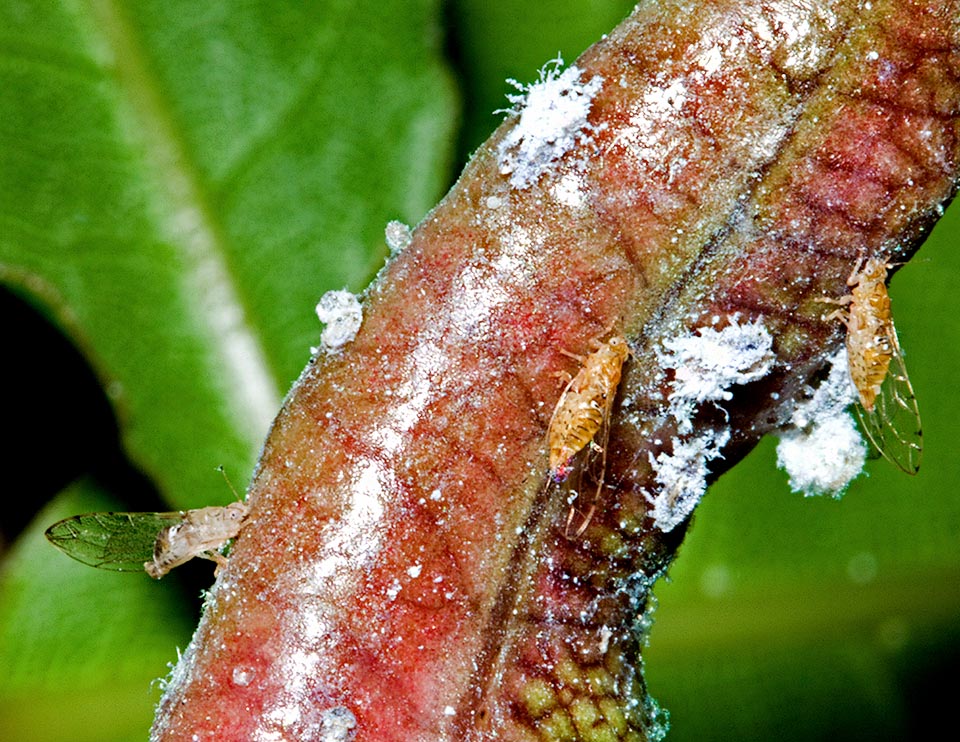
Foliar margin folded with 3 adults and some nymphs. Inside it, in the gall cavity, are laid the eggs and develop the juvenile stages © Giuseppe Mazza
Ecology-Habitat
The Psylla that lives mainly on Laurus nobilis, has been reported on Laurus novocanariensis and on Persea indica. Perfect habitat are the young and luxuriant plants and especially the fences that are frequently pruned to maintain their shape and abundantly fertilized, which causes the remission of a new vegetation that, in turn, favours the demographic explosion of the Trioza.
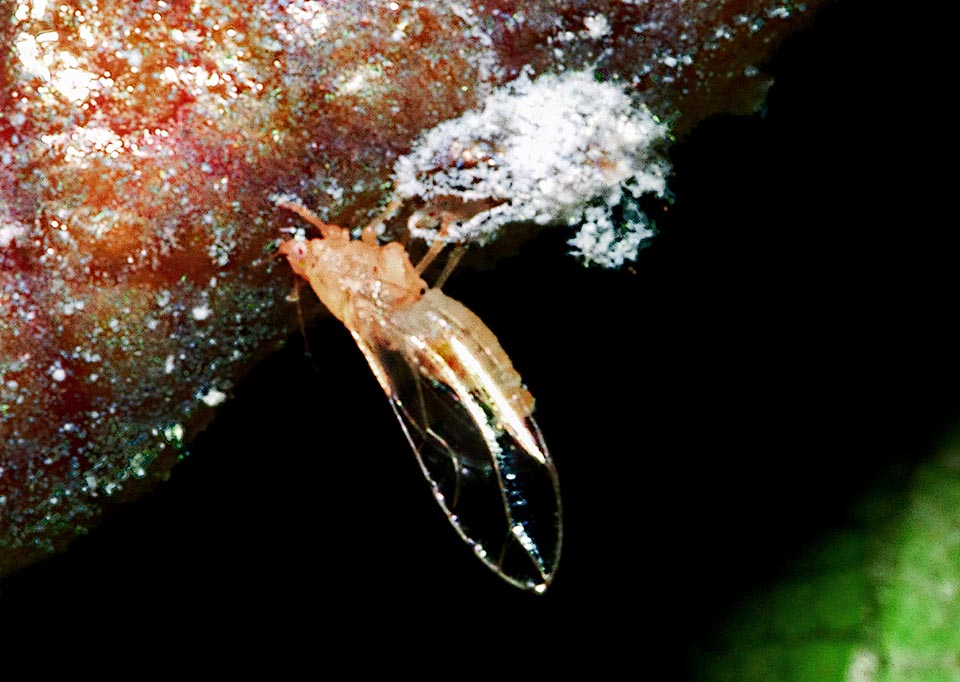
Here an adult of Lauritrioza alacris just emerged from the nymphal exuvia © Giuseppe Mazza
The laurel plants in nursery and those grown for ornamental purposes get the most damages due to the deformation to the vegetative tips, the slowed development and especially due to the sooty molds that develop on the honeydew and stain the crown that takes on an unsightly black colour.
Morphophysiology
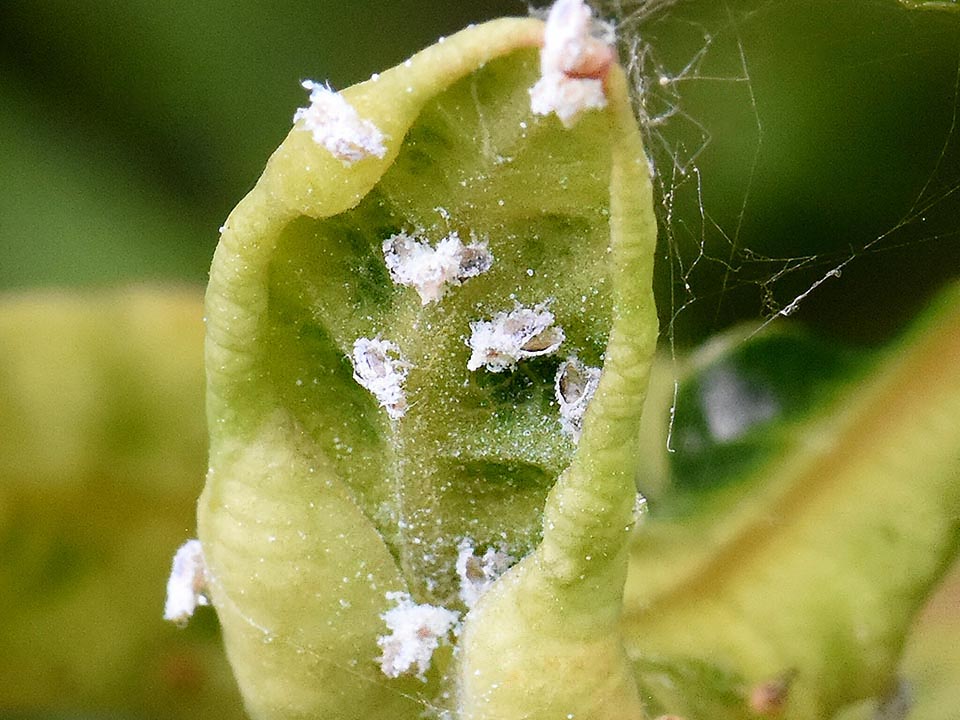
Each female lays an average of a hundred eggs under the curled edges of the leaf. Here an open gall with nymphs migrating out where they will develop © Herman Berteler
The body of the adults of Lauritrioza alacris measures 3,5 to 4 mm; the colour varies significantly with the period of their birth and with the age; dorsally the integument initially yellow, tends to get darker until it becomes black with paler longitudinal and transversal lines.
The last two segments of the antenna arte dark. The wings are long and pointed, with the outer rib short and curved.
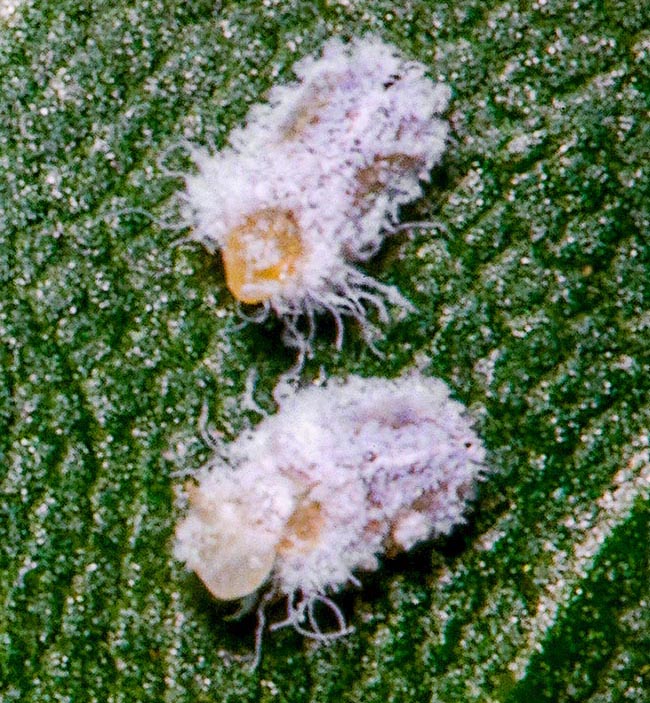
The last nymphal stages, with protective waxy secretions, leave the gall and effect their last moult on the leaves © Giuseppe Mazza
The colour of the body on the juvenile stages varies from yellowish pink to yellowish green, they live inside the galls, often immersed into the honeydew produced by themselves and protected by the dense waxy secretions.
Ethology-Reproductive Biology
The adults survive the coldest season by sheltering especially on the crown of the plants of Laurel.
With the vegetative recovery of the hosts the move to the buds and, with their stinging-sucking mouthparts they feed and inject into the mild tissues the saliva that determines the folding of the foliar edge towards the lower pagina and the formation of a cavity inside which they lay the eggs.
The folded part takes on a blistered appearance and a yellowish-white colour.
Each female lays an average of a hundred eggs under the curled edges of the leaf.
After a few days incubation, varying depending on the ambient temperature, the nymphs are born and begin to feed, pricking the gall walls where they inject more saliva rich in auxinic substances that accelerate the hyperplastic phenomena of the cells.
This is how the characteristic globose gall takes form.
The neanids and the nymphs covered by the waxy white secretions live inside. The last nymphal stages abandon the gall and make their last moult on the leaves. The abandoned galls over time take a typical brown colour, before the fall of the leaves.
Natural limiting factors
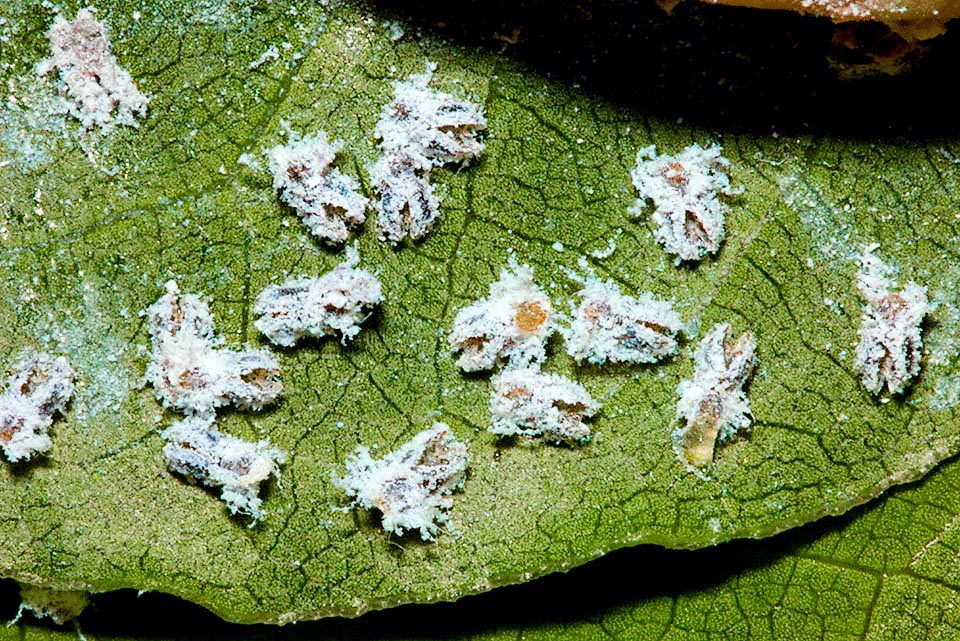
A group of Lauritrioza alacris nymphs ready for emersion. The adults, that promptly reach in flight the new growing leaves, are actively preyed upon by Mantids, Coleoptera and various Heteropteran True bugs. Among these Anthocoris nemoralis is the most active nowadays bred for biological control in the laurel nurseries © Giuseppe Mazza
All biological stages of the Psylla of the Laurel are actively preyed upon by Mantids, by Coleoptera and by various species of Heteropteran True bugs, the most active of which is the Anthocorid, Anthocoris nemoralis (Fabricius 1794) that is also raised in commercial insectaria and utilized in the pear trees orchards for the biological control with the “inundative application” or with the “augmentative control” an dof the harmful Pear Psylla Cacopsylla pyri (Linnaeus, 1761).
Synonyms
The species known as Laurel psyllid in English, Laurbaerbladloppe in Danish, Laurierbladvlo in German and Lagerbladoppa in Swedish, has been described as Trioza alacris by the German entomologist Gustav Flor in 1861, and has been transferred in 1986 into the genus Lauritrioza.
→ To appreciate the biodiversity within the HEMIPTERANS please click here.
